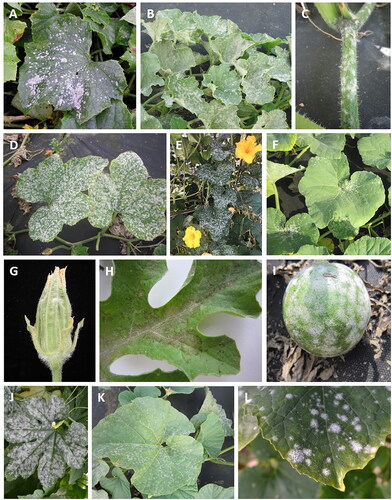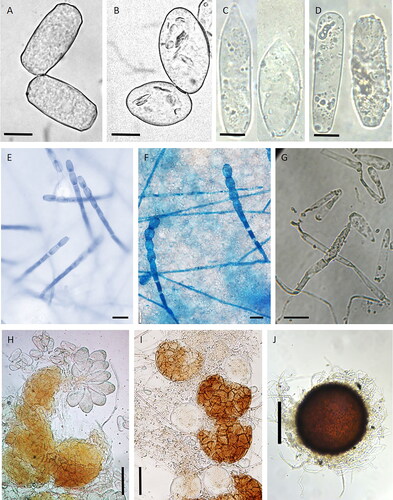Figures & data
Table 1. Commonly produced Cucurbita fruit morphotypes (Paris et al., Citation2012b; Khoury et al., Citation2020; Grumet et al., Citation2021).
Table 2. Seven Citrullus species summarized from Renner et al. (Citation2017), all are 2n = 22 except C. naudinianus (2n = 24).
Figure 1. Macroscopic symptoms of cucurbit powdery mildew on leaves, stems, flower and fruit of eight representatives of Cucurbitaceae: (A) cucumber (Cucumis sativus); (B,C) melon (Cucumis melo); (D,E) summer squash (Cucurbita pepo); (F,G) winter squash (Cucurbita moschata); (H,I) watermelon (Citrullus lanatus); (J) bitter gourd (Momordica charantia); (K) bottle gourd (Lagenaria siceraria); (L) wax gourd (Benincasa hispida). Photo credits: B. Sedláková (A–D, F–I, K–L), N. Dhillon (E,J).

Figure 2. Microscopic characters of cucumber powdery mildews: (A) Golovinomyces orontii (conidia); (B) Podosphaera xanthii (conidia); (C) Leveillula taurica (primary conidia); (D) L. taurica (secondary conidia); (E) G. orontii (conidiophores); (F) P. xanthii (conidiophores); (G) L. taurica (conidiophores); (H) G. orontii (chasmothecium); (I) P. xanthii (chasmothecium); (J) L. taurica (chasmothecium). Photo credits: A. Lebeda (A,B), S. A. Khodaparast (C,D,G,J), L. Trecate (E,F), B. Sedláková (H,I). Bar represents: 10 µm (A–D), 20 µm (E–G), 50 µm (H,I) and 100 µm (J).

Table 3. Current and historical designations of seven Erysiphales species parasitizing members of the Cucurbitaceae family.
Table 4. GRINTable Footnotea accession numbers, septet numbers, sources and origins of the ICPMIb melon (Cucumis melo) cucurbit powdery mildew race differentials (Lebeda et al., Citation2016a; Citation2016b; Citation2018a; Citation2018b; Citation2021a; Citation2021b).
Table 5. Cucumber (Cucumis sativus) genes (synonyms) controlling responses to Podosphaera xanthii and Golovinomyces orontii, and their respective sources per Wehner (Citation2005-2006) and Weng and Wehner (Citation2016).
Table 6. Sources of resistance, mapped and cloned genes/quantitative trait loci (QTL) for powdery mildew resistance in cucumber (Cucumis sativus) summarized from Liu et al. (Citation2021).
Table 7. Melon (Cucumis melo) resistance genes and quantitative trait loci (QTL) to Golovinomyces orontii (Go) and Podosphaera xanthii (Px) and their sources as summarized by Dogimont and Sari (Citation2022).
Table 8. Melon (Cucumis melo) quantitative trait loci (QTL) for resistance to Podosphaera xanthii, including description and number of reported QTL, and their respective parental lines (Dogimont and Sari, Citation2022).
Table 9. Cucurbita spp. genes for cucurbit powdery mildew (CPM) resistance (Paris and Brown, Citation2005; Paris and Kabelka, Citation2009; Paris and Padley, Citation2014-2015).
